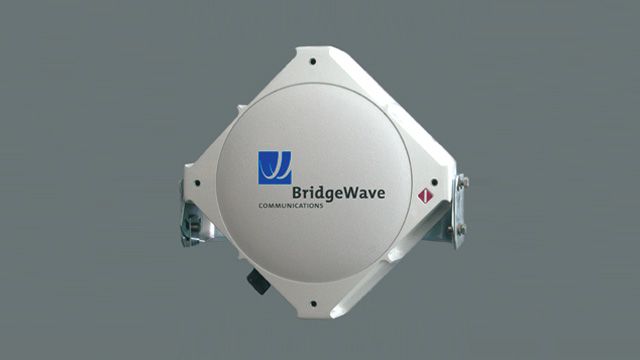BridgeWave Communications Delivers High-Capacity Wireless Links Months Ahead of Schedule
“Building a high-frequency, high-capacity, highly available wireless link is an engineering challenge. Using Simulink, we modeled and simulated the entire design before moving to hardware. Getting into the lab with confidence in the design is a huge benefit.”
Challenge
Solution
Results
- Time-to-market shortened by three months
- First hardware implementation operated as designed
- Communication improved throughout development

Wireless Ethernet links provide secure, reliable, high-capacity connectivity for extending LANs between buildings as well as the reach of fiber networks. Producing those wireless links at competitive prices and getting to market first, however, requires engineers to fully model and simulate their designs before implementing them.
BridgeWave Communications has driven the cost of deploying full-rate gigabit links down to the range of existing 100 Mbps wireless links, enabling users to affordably trade up to gigabit speeds. To maintain product cost and time-to-market leadership, BridgeWave’s engineering team used MathWorks tools for Model-Based Design.
“Using MathWorks tools for Model-Based Design, we were confident that our Ethernet wireless links would deliver the performance we needed,” says Idan Bar-Sade, VP of engineering at BridgeWave. “Simulink enabled us to evaluate different design approaches and parameters, verify the design, and then examine the details of our implementation. We tested and simulated all aspects of the system before building a hardware prototype.”
Challenge
BridgeWave engineers previously used MATLAB ® to develop algorithms and to model and simulate a single system design in their wireless Ethernet link product line. As they moved to a new design platform to support a broad family of new wireless link products, BridgeWave needed a more visual approach that enabled their engineers to assemble designs from existing blocks faster, explore and simulate more design ideas, and communicate the design more effectively—while ensuring complete and accurate simulations of system performance.
“We needed to validate the system and verify performance, while reducing the time to build the models and run simulations,” explains Bar-Sade. “We also wanted to evaluate alternative designs and perform more extensive simulations to establish confidence in the design before building a hardware prototype.”
Solution
BridgeWave used MathWorks tools for Model-Based Design to model and fully simulate the entire wireless link.
A team of engineers first used Simulink® to create a basic model of the system comprising a modulator, demodulator, and a bit-error rate (BER) counter. Because this was their first project using Simulink, they used a wireless model from the MATLAB Central file exchange to accelerate their early simulation efforts.
Using Communications Toolbox™, BridgeWave selected the modulator and demodulator that most closely matched the product specifications. Using Simulink to simulate this baseline model, they produced a BER curve that met the requirements.
Engineers then replaced the modulator with a more realistic simulation created with Simulink blocks of lower-level hardware components. This more detailed design also included filters and other components from DSP System Toolbox™.
The team then followed the same approach with the demodulator, replacing high-level blocks with BridgeWave’s proprietary implementation using Simulink blocks.
Throughout development, engineers used the Simulink modulation and demodulation blocks as a standard for debugging. “Whenever we saw a problem with our modulator implementation, we switched back to the Simulink block and compared results,” says Bar-Sade. “It was a very efficient way to debug our system.”
Engineers used RF Blockset™ to incorporate RF components, including low-noise RF amplifiers, into the design. With RF Blockset, they used measured S-parameter data from existing amplifiers to simulate the devices in Simulink.
Once the team had developed a full system model, they ran simulations in Simulink, using different frequencies, filter bandwidth parameters, gain slopes, and signal-noise levels to fully evaluate the design. “We wanted to be sure—based on manufacturability and cost—that what we built would perform well. It was a big confidence builder to vary parameters and see the stability of our design,” explains Dr. John Park, principal systems engineer at BridgeWave.
“BridgeWave delivered its new FE60 wireless link, the first product based on the new platform, ahead of schedule, producing the longest-range 60GHz wireless Ethernet link on the market,” reports Bar-Sade. “Based on our success on this project, we are confident that MathWorks tools will be key contributors to our future development projects.”
Results
Time-to-market shortened by three months. “Using MathWorks tools for Model-Based Design, we improved productivity and completed the design in about half of the time that I would have expected,” says Bar-Sade. “We shortened the overall time-to-market by more than three months on an eight-month project.”
First hardware implementation operated as designed. “Our design worked from the first prototype that we built. The hardware system performance was exactly the performance that we saw in Simulink, so we minimized our number of board spins. That saved us a lot of time and effort and increased our confidence moving forward,” reports Bar-Sade.
Communication improved throughout development. Simulink enabled BridgeWave to create and validate an executable specification to ensure clear communication among engineers and management. “With its visual block-diagram environment, Simulink is easy to use and makes the design and the simulation results easy to understand and straightforward,” says Park.